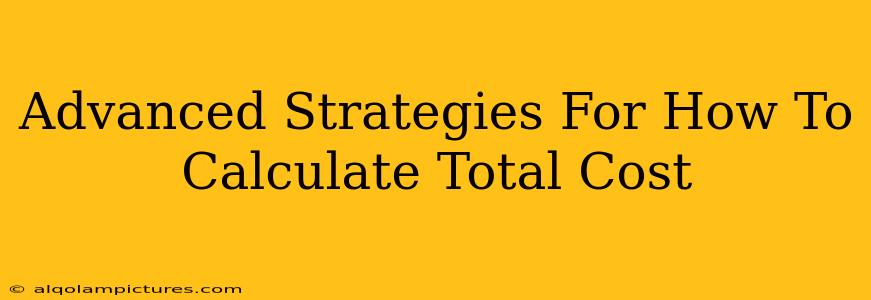Calculating total cost might seem straightforward at first glance, but mastering the nuances is crucial for accurate business planning and informed decision-making. This guide delves into advanced strategies beyond the basics, equipping you with the knowledge to handle complex scenarios and optimize your cost analysis.
Beyond the Basics: Unveiling Hidden Costs
While the simple formula of Total Cost = Fixed Costs + Variable Costs serves as a foundation, real-world applications require a more nuanced approach. Many hidden or indirect costs can significantly impact your bottom line if overlooked.
1. Identifying and Quantifying Hidden Costs
-
Opportunity Costs: This often-overlooked cost represents the potential benefits you miss out on by choosing one option over another. For example, the opportunity cost of investing in Project A might be the potential profits from investing in Project B. Quantifying this requires careful consideration of potential returns from alternative investments.
-
Sunk Costs: These are past expenses that are unrecoverable. While irrelevant for future decision-making, acknowledging sunk costs helps avoid emotional biases influencing your choices. For instance, continuing to invest in a failing product due to significant prior investment is a classic sunk cost fallacy. Focus on future prospects, not past expenses.
-
Indirect Costs (Overhead): These costs aren't directly tied to producing a specific good or service but are essential for business operations. Examples include rent, utilities, and administrative salaries. Accurate allocation of overhead costs across different products or departments is crucial for proper pricing and profitability analysis.
2. Advanced Cost Allocation Methods
Simple cost allocation methods may not suffice for complex businesses. Explore more sophisticated techniques:
-
Activity-Based Costing (ABC): ABC assigns costs based on the activities that consume resources. This provides a more accurate picture of cost drivers compared to traditional methods that rely on broad allocations. ABC is especially beneficial for businesses with diverse product lines or complex production processes.
-
Throughput Accounting: This method focuses on maximizing throughput (revenue generated from sales) while minimizing operating expenses and inventory. It's particularly relevant for manufacturing environments with high inventory levels.
Handling Variable Costs Effectively
Variable costs, which fluctuate with production volume, require careful monitoring and forecasting.
3. Forecasting Variable Costs
Accurate forecasting is key. Consider using techniques like:
-
Regression Analysis: This statistical method helps identify the relationship between variable costs and production volume, allowing for more precise predictions. Requires historical data and understanding of statistical concepts.
-
Trend Analysis: Analyzing past cost trends can provide insights for future forecasting. However, consider external factors that may affect trends, like inflation or changes in raw material prices.
4. Managing Variable Costs
- Negotiate with Suppliers: Secure favorable pricing and payment terms with suppliers to reduce material costs.
- Optimize Production Processes: Streamline operations to minimize waste and improve efficiency.
- Explore Alternative Materials: Research and potentially switch to cost-effective materials without compromising quality.
Leveraging Technology for Cost Calculation
Modern tools significantly simplify and enhance the accuracy of total cost calculations.
5. Cost Accounting Software
Dedicated software solutions automate cost tracking, allocation, and reporting, reducing manual effort and minimizing errors. Choose software that aligns with your business's specific needs and complexity.
6. Data Analytics
By leveraging data analytics, you can gain valuable insights into cost drivers, identify areas for improvement, and make data-driven decisions for cost optimization. This involves analyzing historical cost data, market trends, and other relevant factors.
Conclusion: Mastering Total Cost Calculation for Strategic Advantage
Mastering the art of total cost calculation goes beyond basic formulas. By understanding hidden costs, employing advanced allocation methods, effectively managing variable costs, and leveraging technology, you can gain a significant competitive advantage. Accurate cost analysis empowers informed pricing strategies, efficient resource allocation, and ultimately, increased profitability. Regularly review and refine your cost calculation methods to adapt to changing business conditions and maintain a strong financial foundation.

